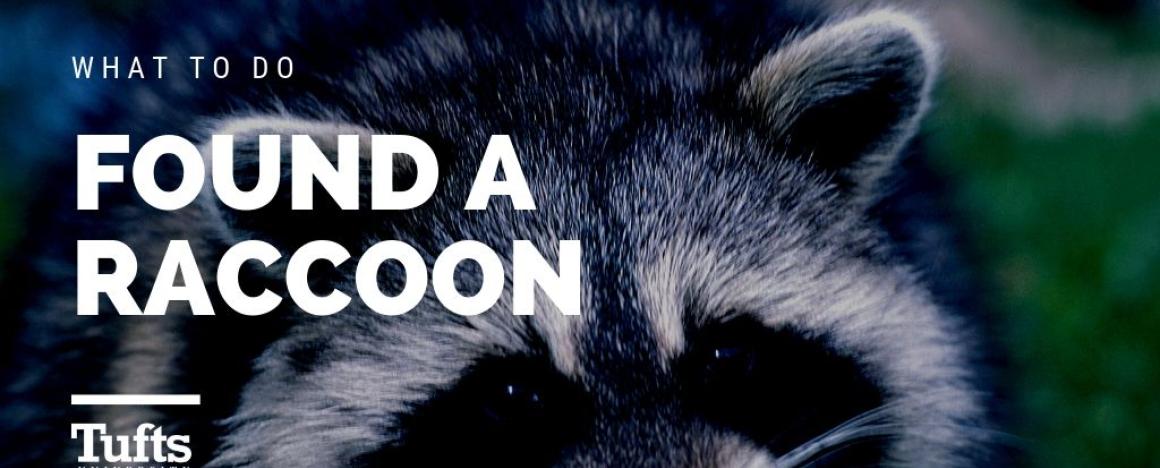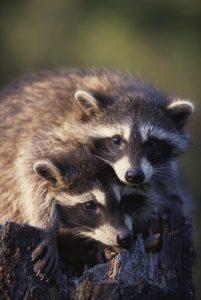What To Do If You Found a Raccoon

About Baby Raccoons

Caution: Rabies vector species. Always wear gloves when handling.
Orphan Alert: Be very careful not to create orphan raccoons by accident. When a baby raccoon is separated from its mother during the night, the baby will stay where it is until the mother returns, which may not be until the next night. People often find a sleeping baby raccoon and will assume it needs to be rescued. However, it is likely that the mother will be back after dark. If the baby raccoon is not in imminent danger, it’s best to observe the baby for another 24 hours without disturbing it. Unnecessarily removing an animal from its environment – particularly a baby – can cause more harm than simply leaving it be. It is important to recognize signs of distress.
There are a few cases where you might need to intervene:
- The baby raccoon has been crying continuously.
- The baby raccoon remains in the same spot for 24 hours.
- The eyes are closed, and the baby raccoon is alone. (No mother)
- The baby raccoon is lying stretched out and is cold to the touch.
- The mother has been removed, relocated or is dead.
- The baby raccoon is injured or has been attacked.
- The baby raccoon walks up to humans non-aggressively.
- There are flies around the baby raccoon.
If you know of an animal who needs help, please call your local animal control officer, a licensed wildlife rehabilitator, or the Tufts Wildlife Clinic as soon as possible.
About Raccoons
Raccoon Removal Alert
Mother raccoons often give birth in the spring in and around our homes. When homeowners hire pest control companies to remove the mother, the babies will be left behind. The best solution is to wait a few weeks to remove the raccoons until the babies are mobile and join their mother for foraging. After they’ve left your dwelling for the evening, it’s safe to close their access for good.
Injured Adult Raccoons
Do not handle, feed, or transport injured adult raccoons. Adult raccoons can be very aggressive, can move quickly, and can cause serious injury to you and others.
What to do – if it is safe to do so
If none of the above resources are available, and the animal is in need of immediate assistance, you may attempt rescue ONLY if it is safe to do so.
Protect Yourself
Wear gloves. When dealing with non-carnivorous mammals, a thick pair of work gloves, a thick jacket, and other personal protection can prevent injury. All mammals can carry the rabies virus. Do not use bare hands when helping mammals. Please be careful not to get bitten, licked, or scratched by the animal.
Prepare a Container
Have a sturdy box or animal carrier ready to contain the animal. Garbage cans, recycling bins, and plastic containers will work in a pinch, depending on the size of the animal. Make sure that you have a lid that will fit securely to the top of the box.
Capturing the Animal
Approach the animal from behind, drop the towel over the animal, including the head, quickly gather the animal in the towel, then immediately place it into the container. Cover and seal the box to ensure that the animal cannot escape from the container.
Transport
For further assistance on Transport, please refer to the "Who to Call for Help" section on this page.
During transport, keep the animal in the box or crate, keep the car quiet (radio off).
DO NOT keep the animal for any length of time, e.g. overnight. Place the animal in the container in the back seat of your vehicle, not in the car trunk, and monitor during transport to make sure it is not escaping!
PLEASE NOTE! Tufts Wildlife Clinic is not able to rehabilitate rabies-vector species but will humanely euthanize these animals if they are brought to us. Due to the Covid pandemic, bats are an exception to this rule at this current time.
For further information on rabies, visit the Mass Health & Human Services Department’s Rabies Information page.
About Rabies-Vector Species
If you have found an orphaned, sick or injured raccoon, woodchuck, skunk (Caution: can spray), or bat, DO NOT touch this animal with your bare hands. All of these species are considered to be rabies vector species, which means that they are the most common wildlife species in Massachusetts that transmit rabies to other animals or people. Rabies is a viral disease that is usually spread through the affected animal’s saliva and enters another animal or person through a break in the skin or contact with the eyes, nose or mouth. From there, it spreads to the nervous system and, in almost 100% of cases, leads to eventual death. If you find an injured or sick raccoon, woodchuck, skunk, or bat, you should call one of the following numbers for assistance:
- Your local Massachusetts Animal Control Officers
- A wildlife rehabilitator near you
- Other professionals
Circumstances that are NOT safe include sick or injured juvenile or adult raccoons, woodchucks, skunks or bats that:
- are still alert to your presence
- can readily move around
- and/or are located in an area that is unsafe for rescue, e.g. in the middle of the road.
While the rabies virus is usually spread through a scratch or bite wound, any bare-handed contact that you have with a rabies-vector species is considered potential exposure. The only way to test if an animal has rabies is through testing of brain tissue. Therefore, if you have any bare-handed contact or are scratched or bitten by a rabies-vector species, that wild animal will have to be euthanized for rabies testing.